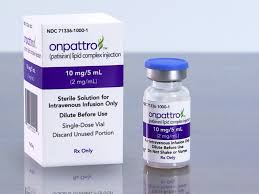 On August 13, the U.S. Food and Drug Administration (FDA) approved Alnylam’s Onpattro (patisiran), rapidly followed by that product’s approval in Europe three weeks later. Onpattro, which we previously wrote about, is the first RNAi-based treatment to reach the marketplace. It is intended to treat peripheral nerve disease caused by a rare genetic condition called hereditary ATTR amyloidosis (hATTR).
On August 13, the U.S. Food and Drug Administration (FDA) approved Alnylam’s Onpattro (patisiran), rapidly followed by that product’s approval in Europe three weeks later. Onpattro, which we previously wrote about, is the first RNAi-based treatment to reach the marketplace. It is intended to treat peripheral nerve disease caused by a rare genetic condition called hereditary ATTR amyloidosis (hATTR).
Alnylam set a very high price for its new product, $450,000 per year, which they expect to yield $345,000 per year after rebates and discounts. The company justified the high price as a “fair reward” for the 16 years of research leading to “a new class of medications that has the potential to transform the treatment” of the disease for which it was approved.
Alnylam said it was working with commercial insurers on value-based pricing agreements to help speed coverage decisions for patients. They also plan to offer co-pay assistance for eligible patients and to provide the drug for free of charge to those without insurance or whose insurance declines to cover the costly treatment.
Drug pricing watchdog ICER has objected to the Onpattro price tag. They issued a report criticizing Alnylam’s pricing, saying that they believed a fair price should be 90-95% of what Alnylam has set. ICER is questioning whether the data accrued by Alnylam so far truly translates to a higher quality of life for patients. Given ICER’s growing clout with insurers, it will be interesting to see how their finding will ultimately impact Alnylam’s pricing for Onpattro — as well as other drugs to treat ATTR amyloidosis.
The first competitor to the Alnylam product, Tegsedi (inotersen), developed by collaborators Ionis and Akcea, received FDA approval on October 5. Another antisense drug designed to treat hATTR, Tegsedi, has been priced at the same level as Onpattro. Tegsedi comes with more safety concerns than Onpattro, including boxed warning information. However, Tegsedi offers the convenience of weekly self-administered injections, rather than the intravenous infusion that Onpattro requires, which may lead to a lower cost of care. Pfizer is also likely to enter the market in 2019 with a competing product, and they are already instituting an expanded access program for patients with the disease in order to be ready for FDA approval.
Will ICER’s claim that the $450,000 Onpattro’s price tag is much too high ultimately cause companies to rethink their pricing decision? What impact will ICER’s finding have on Onpattro’s and Tegsedi’s insurance coverage? And how will competition ultimately affect drug pricing in this indication, given that there will soon be at least three products available?